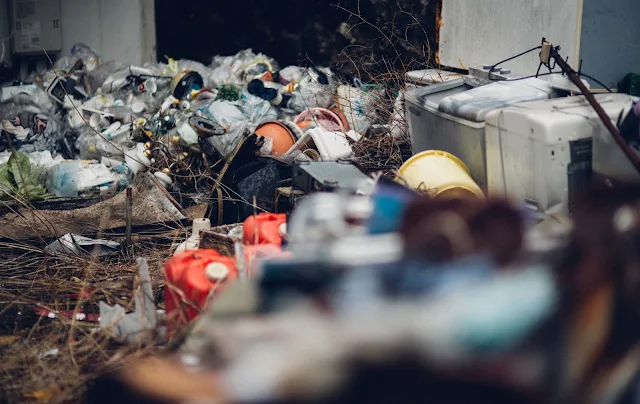
Hoarder houses, often referred to as "garbage houses," are a growing concern in society today.
These houses are characterized by the accumulation of excessive amounts of garbage and clutter, which are left in a disorganized state.
While hoarding behavior can be seen as a manifestation of obsessive-compulsive disorder (OCD), it is important to note that not all hoarders have OCD.
In this article, we will explore the causes, impacts, and possible solutions to hoarder houses, shedding light on this complex issue.
{tocify} $title={Table of Contents}
What are Hoarder Houses?
Hoarder houses are buildings, primarily residential, where garbage is piled up and left in an unorganized manner.
They are not official garbage collection sites but rather private properties or land where residents accumulate garbage.
Hoarders may collect their own waste, transport garbage from nearby collection points, or accumulate garbage due to involvement in recycling activities.
From a psychiatric perspective, hoarding behavior is classified as one subtype of obsessive-compulsive disorder (OCD) known as "compulsive hoarding."
This condition is characterized by the excessive acquisition of items and the inability to discard them, leading to a cluttered living environment.
In 2013, the American Psychiatric Association officially recognized hoarding disorder as a distinct mental illness in the DSM-5.
Hoarder houses pose various problems, such as the generation of foul odors, the attraction of pests like rats and insects, and increased vulnerability to crimes like arson.
These issues have brought hoarder houses into the spotlight, with widespread media coverage and discussions about them as a social problem.
The Social Impact of Hoarder Houses
Hoarder houses have gained attention as a social problem due to their negative impact on communities and individuals.
The following are some general situations that have been widely reported, although it is important to note that hoarder houses can vary significantly in their circumstances:
General Situations
Many individuals who create hoarder houses are the owners of the property themselves.
In some cases, they may be wealthy individuals who own multiple properties in the vicinity.
Often, hoarders are elderly and live alone, either due to being unmarried, separated, widowed, or simply socially isolated.
This social isolation is considered one of the contributing factors to the formation of hoarder houses.
Once a hoarder house is established, it becomes increasingly difficult for the residents to clean up the clutter on their own, leading to a worsening situation.
In legal terms, even if a third party can clearly see that a property is filled with garbage, it is challenging to intervene and forcibly remove the clutter if the owner denies that it is garbage.
Additionally, if the property is privately owned, unauthorized entry may constitute an offense such as trespassing, making problem resolution even more difficult.
Another scenario involves unoccupied houses or properties that have been abandoned for an extended period.
In these cases, neighboring residents may repeatedly illegally dispose of their garbage on the property, and the current owner fails to take any countermeasures.
In such instances, the problem is not directly caused by the owner of the hoarder house but rather by the lack of moral responsibility and unlawful actions by nearby residents.
Recognition of Hoarder Houses
According to a survey conducted by the Ministry of the Environment in Japan between April 2018 and September 2022, 101 out of 1741 municipalities (38.0%) recognized a total of 5224 cases of hoarder houses.
Of these cases, 2588 (49.5%) were resolved, while the remaining 2636 cases (50.5%) remained unresolved.
Tokyo had the highest number of recognized cases with 880, followed by Aichi with 538 and Chiba with 341 cases.
Among the resolved cases, Hiroshima had the highest improvement rate at 74.6%, followed by Aichi at 72.9%.
The improvement rates were attributed to factors such as advice and guidance to residents, residents' relocation or death, and comprehensive support from relevant departments and organizations.
Understanding the Background of Hoarder Houses
Hoarder houses can have various underlying causes, making it difficult to generalize the phenomenon.
However, based on reported cases, the following reasons are often associated with the development of hoarder houses.
It is important to note that many hoarders may not be aware of the severity of their situation.
Compulsive Hoarding as an Abnormal Behavior
- Anger towards illegal dumping of garbage on one's property.
- Distrust towards the community or relatives leads to anxiety about personal safety and possessions.
- Achieving a sense of accomplishment through collecting various items.
- Feeling guilty about disposing of items.
- Social exclusion and isolation from the community.
- Pathological escalation of collecting behavior.
Other reasons for hoarding houses include:
Hoarding Disorder
Hoarding disorder is often identified as the underlying cause of hoarder houses.
It is characterized by persistent difficulty in discarding possessions, regardless of their actual value, leading to an overwhelming accumulation of items that impairs the functioning of living spaces.
While hoarding disorder typically emerges during early adulthood and gradually worsens with age, it is estimated to affect 2-6% of the population.
Approaches by Local Authorities
Local authorities have been working to address the issue of hoarder houses through various means.
Some municipalities have enacted specific regulations to deal with hoarding behavior and the accumulation of garbage.
However, few local governments have actually enforced the removal of garbage through administrative measures.
In 2008, the city of Mishima in Shizuoka Prefecture, Japan, intervened in a hoarder house case based on concerns about the safety and well-being of an elderly female resident.
They invoked the Elder Abuse Prevention Act to take action.
In Beppu City, Oita Prefecture, unclaimed houses or properties left unattended for long periods have become targets for illegal garbage dumping by neighboring residents.
In such cases, the issue is caused by the lack of morals and unlawful actions of a few individuals, rather than the hoarder house owner.
Some municipalities, such as Suginami, Ota, and Arakawa in Tokyo, have established ordinances that require the owners of hoarder houses to bear the cost of forced removal of garbage.
Additionally, Adachi Ward in Tokyo is considering a new ordinance to provide financial support for hoarders who cannot afford the cost of forced removal, with the ward covering expenses up to one million yen.
It is worth noting that financial assistance from local authorities for garbage removal is rare nationwide.
According to a survey conducted by the Mainichi Shimbun in October 2016, out of 74 cities and wards in designated cities, prefectural capitals, and the 23 special wards of Tokyo, only 16% have enacted specific ordinances to address hoarder houses.
Experts argue that hoarder house incidents can happen to anyone, not just the elderly, and call for the Japanese government to take action rather than leaving the responsibility solely to local authorities.
Forced Removal of Hoarder Houses
In Kyoto City, Japan, the first case of forced removal of garbage from private property occurred in November 2015 based on the "Ordinance on Support and Measures for Resolving Poor Living Environments in Kyoto City."
The city carried out administrative enforcement to remove garbage piled up in front of a property belonging to a man in his 50s.
This marked the first instance of forced removal of garbage from a privately owned property in Japan.
The decision was made due to concerns that the excessive garbage obstructed the pathway, posing a potential threat to the safety of residents and emergency responders.
Conclusion
Hoarder houses present a complex social issue with significant impacts on individuals and communities.
Understanding the underlying causes and implementing effective solutions is crucial for addressing this problem.
Through increased awareness, support from local authorities, and a deeper understanding of hoarding disorders, we can work towards creating safer and healthier living environments for everyone.

Your Gateway to Japan's Wonders! Immerse yourself in the beauty, culture, and adventures that Japan has to offer.
Check It Out!
Post a Comment